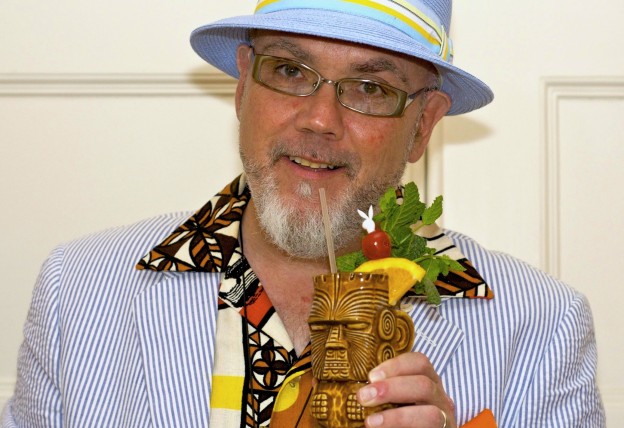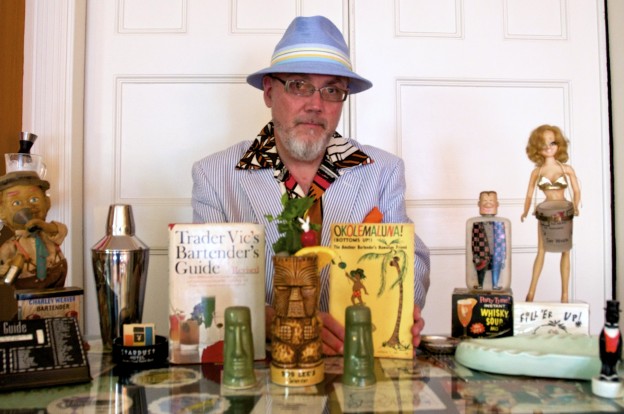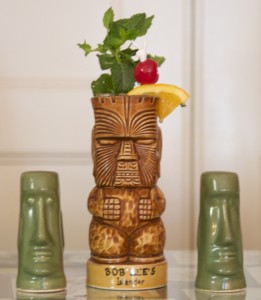In local cocktail circles there are a few legendary characters, but perhaps none as beloved and influential as Brother Cleve. He is often referred to as the Godfather of the city’s cocktail revival, inspiring Boston bartending luminaries like Misty Kalkofen (Drink), Jackson Cannon (Eastern Standard/ICOB), John Gertsen (Drink), Dylan Black (Green Street) and a list of others that’s probably too long to mention.
His apartment in the Uphams Corner part of Dorchester is brimming with old cocktail books, vintage drink menus and other spirit-related paraphernalia from shakers and exotic glassware to coasters and kitschy cocktail magazines. It is the height of cocktail cool. The kicker, though, is the small bar that is the focal point of the living room — It’s one of the swankiest home bars I’ve ever seen and one can only imagine the vast array of liquor nestled within and behind its funky studded duo-tone leather exterior. Brother Cleve is a seasoned collector and he’s got style.
When we meet, the man himself is dressed to the nines in a natty summer suit jacket, a bright hawaiian shirt, white loafers (with bowling socks), and a blue straw hat. As we talk, there’s a steady soundtrack of classic lounge music and exotica; Bossa Nova rhythms percolate in the background. It’s the perfect home cocktail lounge with just the right amount of theater.
“Bartending really is show biz,” Cleve says. “I’ve been in show biz my entire life, on stage performing with bands or as a DJ, and bartending is really just an extension of that.”
Brother Cleve is probably best known as a DJ and musician. Over the years he’s played keyboard in numerous Boston bands. He is also one of the true pioneers of the resurgent international lounge music and exotica scene. His musical interests and his fascination with cocktails have always been tightly intertwined. In the 1990s he was a member of Combustible Edison, a modern lounge and exotica ensemble, which extolled the virtues all things cocktail. They had a signature drink, sold mini-cocktail kits, and were sponsored by Campari — all at the height of the popularity of grunge music and Nirvana.
In 1985,Cleve had what he describes as his “cocktail revelation.” It happened in one of the more unlikely spots, a diner in Cleveland, Ohio, when he was on tour with the very un-cocktail-centric band, the Del Fuegos, who at the time were sponsored by Miller beer.
“It was one of those places with a cocktail menu with like 50 to 100 cocktails listed on it. Now I always drank Manhattans and Martinis, even as a punk rocker at the Rat in the seventies, but I remember looking at this and thinking, ‘Wow! there are so many cocktails out there. I had no idea! Oh, yeah, look, a Sidecar! I think my grandmother used to drink those, but what the hell is it?'”
He left the diner that day determined to find the answer. He began by picking up an old copy of a Mr. Boston Bartender’s Guide at a local used bookstore and never looked back.
Eventually, around the same time he was in Combustible Edison, he was organizing parties and club nights that featured lounge, exotica and easy listening music. For each party, there was a different signature cocktail. It was at the most popular of these regular gigs, a night called Saturnalia at the Lizard Lounge, that a young Misty Kalkofen began to learn the art of mixing classic drinks with Cleve acting as a kind of mentor/coach. As anyone who’s had a drink made by Misty, she learned these lessons well. “Misty is the greatest bartender I know,” Cleve says. “Anything she makes is perfection in a glass.”
After Saturnalia, the nascent cocktail scene really began to take shape and Cleve was in the thick of the action. He helped open the B-Side Lounge, which was one of the first craft cocktail bars in the country. At the B-Side, he co-created their extensive drink menu (with Patrick Sullivan) and held court behind the bar on Monday nights. His influence on the subsequent revival in Boston was tremendous, but his time bartending in the last decade has been scant. Music has been his full-time gig — between DJing and playing in the band the Singhs, he pays the bills and travels the world, but that’s left precious little time for barwork.
In addition, illness forced him to give up drinking for almost three years. “My friends were more concerned about my not drinking than I was,” he says. But this year, with a clean bill of health and his band on year-long hiatus, he has returned behind the bar.
He started at Think Tank in Cambridge earlier this year with a weekly Monday night event called “Drink This!,” which featured a different set of classic cocktails and a drink or two of Cleve’s own creation. The night was an immediate success. For the summer, however, Cleve decided to switch things up and focus on a single style of drinks. He chose Tiki, the faux-Polynesian style of cocktails made famous in lounges such as Trader Vic’s, in the fifties. It is a particular passion of his, jibing neatly with his love of exotic ingredients and ornate presentation, and it doesn’t hurt that it requires copious amounts and varieties of rum, which is one of Cleve’s favorite spirits. Oh, yes, and the music is pretty great, too.
Equally important is Tiki’s colorful past and history. Recreating the various cocktails, modern bartenders had to engage in a kind of archaelogical inquiry, unearthing forgotten ingredients and decoding recipes. Often, the exact ingredients were deliberately obscured by the various bartenders and club owners. It all adds up to some great material for storytelling and Cleve is a born raconteur.
“You know there’s a story in every glass,” he says, “And I like to share those stories, because I’ve be into this stuff for a long time.”
“Not all the stories are true,” he says with a laugh, “but they’re always good!”
For a favorite drink, Cleve offers two versions of a Suffering Bastard. This classic Tiki drink was made famous by Trader Vic. Forget any syrupy concoctions you’ve had at Chinese restaurants over the years: When properly made, the Suffering Bastard is a beautiful drink.
Suffering Bastard (Trader Vic)
1 oz light Puerto Rican rum (DonQ, Ron de Barrilito or Bacardi)
2 oz Martinique rhum agricole (Clement, La Favorite of J.M. brands)
1/2 oz orgeat syrup (almond syrup, available at well stocked liquor stores, coffee shops or Italian specialty shops; also known as Orzata syrup)
1/2 oz lime juice
1/2 oz orange curaçao
1/2 fresh squeezed orange juice
Combine all ingredients in a shaker with ice. Shake and pour everything into a tall collins glass. Top with crushed ice. Garnish with maraschino cherry and orange slice
Suffering Bastard (Joe Scialom)
1 oz gin
1 oz brandy
1 oz Rose’s Lime Juice
2 dashes Angostura bitters
Fill w/ginger beer or ale
TIKI MONDAYS take place every Monday night at Think Tank in Cambridge throughout the summer.




Pingback: Music: Exotica for Modern Living | Ultra Swank
Pingback: Tiki Time at Home: Making Your Own Orgeat Syrup | Public Radio Kitchen